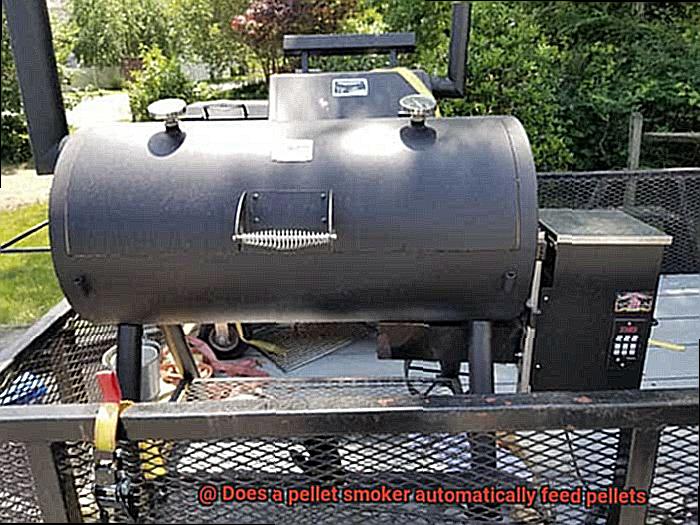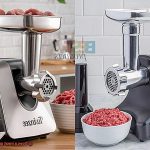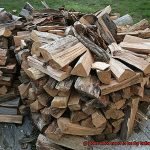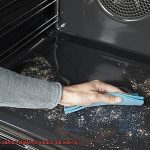Are you a BBQ aficionado on the hunt for the perfect smoker? Before you make your purchase, it’s essential to understand one of the most important functions of a pellet smoker: pellet feeding.
Pellet feeders are what make pellet smokers so popular among BBQ enthusiasts. They can provide up to 20 hours of continuous, effortless cooking, making them ideal for slow-cooking cuts like brisket or pork shoulder. But how do these feeders work, and do all pellet smokers come equipped with them?
The answer is simple: yes. Most pellet smokers come with an automatic pellet feeder that dispenses wood pellets into the smoker’s fire pot via an auger. This hopper is essentially a container for the wood pellets that fuel the smoker.
But not all pellet smokers are created equal – some models boast larger hoppers, allowing you to smoke for longer periods without reloading. Others have more efficient feeding systems that ensure a steady supply of pellets and consistent heat output.
Before investing in a pellet smoker, research different types of feeders and hoppers available to find one that fits your needs and delivers the best cooking experience possible. Trust us; it’ll be worth it when you’re enjoying perfectly smoked meat at your next backyard BBQ.
Contents
How Do Pellet Smokers Work?
A pellet smoker may be the perfect solution for you. But how exactly do pellet smokers work?
Pellet smokers use an electric auger to feed wood pellets from a hopper into a fire pot. The pellets are then ignited by a heating element, creating smoke and heat to cook your food. To regulate the temperature, a digital controller is used to monitor the speed of the auger and the amount of pellets fed into the fire pot.
One of the most significant advantages of pellet smokers is their automatic feeding system. This means that once you’ve filled the hopper with pellets, the smoker does all the work for you. The device will automatically feed pellets into the fire pot as needed, without any intervention from you. This not only saves time but also eliminates the need for constant monitoring and adjustments.
The automatic feeding system works by using a motorized auger to move the pellets from the hopper into the fire pot. The digital controller monitors the temperature inside the cooking chamber and adjusts the speed of the auger accordingly. When more heat is required, it speeds up the auger to feed more pellets into the fire pot. Conversely, when less heat is necessary, it slows down or stops the auger to reduce the amount of pellets being fed.
Pellet smokers come in various models with varying features like programmable temperature settings and multiple hopper sizes. It’s essential to do your research and choose a model that meets your specific needs and preferences.
Benefits of an Automatic Feeding System
Say hello to the automatic feeding system – a game-changing feature that offers numerous benefits for pellet smokers. Here are just a few reasons why an automatic feeding system is a must-have addition to your smoker:
- Consistent Temperature Control: The automatic feeding system ensures that your smoker maintains a consistent temperature throughout the cooking process. This means no more worrying about adjusting the airflow or constantly monitoring the temperature. You can set it and forget it, allowing you to focus on other important tasks.
- Extended Cooking Time: The hopper in an automatic feeding system can hold up to 20 pounds of pellets, which means you can cook for an extended period without having to constantly refill the hopper. This feature is incredibly useful for those long smoking sessions or when cooking for a large group.
- Customizable Smokiness: The amount of pellets fed into the smoker determines the level of smoke produced, which impacts the flavor of your food. With the automatic feeding system, you can adjust the rate of pellet feed, allowing you to customize the level of smokiness to suit your preference. Experiment with different levels of smoke and find that perfect balance for your taste buds.
- Energy Efficiency: The automatic feeding system promotes energy efficiency by feeding pellets only when needed, ensuring that no pellets are wasted unnecessarily. This feature is particularly useful in areas where pellets are scarce or expensive, making it a budget-friendly option for those on a tight budget.
Types of Pellet Smokers
Whether you’re a beginner or an experienced griller, there is a type of pellet smoker that will cater to your needs. In this article, we will explore the various types of pellet smokers available in the market and their unique features.
The first type of pellet smoker is the standard model, which automatically feeds pellets into the firebox using an auger system. This type of smoker is perfect for beginners who want to achieve a consistent result without having to constantly monitor their grill. With a steady flow of pellets, this smoker maintains a consistent temperature and smoke output, making it easy to use.
On the other hand, if you are an experienced griller who wants more control over your cooking process, then a PID-controlled pellet smoker might be more suitable for you. This type of smoker has a programmable controller that allows for precise temperature control and monitoring. The PID controller regulates the amount of pellets fed into the firebox, ensuring a consistent heat output, making it perfect for those who want more control over their cooking process.
The third type of pellet smoker is the Wi-Fi enabled model. This type of smoker can be controlled remotely using a smartphone app or computer. The app allows you to monitor and adjust the temperature of your smoker from anywhere, making it perfect for busy grillers who want to keep an eye on their food while on-the-go. With this feature, you can have peace of mind knowing that your food is cooking perfectly even if you’re not at home.
Lastly, there are combination pellet and gas grills available in the market. These types of grills offer the versatility of both charcoal and gas grilling, as well as the convenience and consistency of pellet smoking. They come with multiple cooking chambers, allowing you to cook different types of food simultaneously. This feature makes them perfect for those who want to experiment with different cooking methods.
What to Consider When Buying a Pellet Smoker
Here are five factors to consider before making your purchase:
Automatic Pellet Feeding: Pellet smokers use compressed wood pellets as fuel, which are fed into the smoker’s firebox by an auger system. Look for a model with an automatic pellet feeding system that can handle extended smoking sessions without constant refilling. This feature will allow you to focus on cooking and entertaining your guests without worrying about constantly adding pellets.
Size: Consider how much food you plan to cook at once. If you’re only cooking for a small family, a smaller smoker may suffice. However, if you’re planning on hosting large gatherings and cooking for a crowd, a larger smoker will be necessary. Make sure the size of the smoker fits your needs.
Construction: The quality of the smoker construction is crucial in ensuring that your investment lasts for years to come. Pellet smokers can be made from various materials such as stainless steel, cast iron, and aluminum. Stainless steel offers durability and resistance to rust and corrosion, while cast iron retains heat well. Aluminum is lightweight and easy to move around, making it an excellent option for those who frequently move their smoker around.
Temperature Range: The temperature range of the smoker is another important factor to consider when buying a pellet smoker. Look for models with adjustable settings that allow for precise temperature control and smoke output. Make sure the temperature range is wide enough to allow for both low and high-temperature cooking. This will give you greater control over the cooking process and ensure that your food is cooked perfectly every time.
Price: While it’s tempting to opt for a cheaper model, investing in a high-quality smoker will pay off in the long run. Pellet smokers can range in price from a few hundred dollars to several thousand dollars. Consider your budget and choose a smoker that meets your needs and budget.
Tips for Using a Pellet Smoker with Automatic Feeding
Pellet smokers with automatic feeding offer a convenient way to grill delicious meals, but to get the most out of your grill, you need to follow some tips. Here are five sub-sections that expand on the tips for using a pellet smoker with automatic feeding:
Understand Your Pellet Smoker
It’s crucial to understand how your pellet smoker works before you start grilling. Each model may have different requirements or settings for the automatic feeding mechanism. So, read the manual thoroughly and familiarize yourself with your smoker.
Keep Enough Pellets in the Hopper
Running out of pellets during grilling can be frustrating and may ruin your meal. Therefore, ensure that you have enough high-quality pellets stored in a dry place so that you’re always prepared to refill the hopper.
Temperature Control is Key
The thermostat regulates the temperature inside the grill, and the rate at which pellets are fed into the firebox is controlled by it. Different types of meat and cooking methods may require different temperature settings, so pay attention to the thermostat and adjust accordingly. Also, be aware of any hot spots or areas that cook faster than others and rotate your food as needed.
Regular Cleaning is Necessary
The automatic feeding system produces ash and debris, which can clog up the auger and reduce its effectiveness. As a result, empty out any ash or debris after each use and give your grill a thorough cleaning every few months.
Lubricate Auger System
Occasionally lubricating the auger system can keep it running smoothly and prevent any build-up or blockages that could cause issues with the automatic feeding mechanism.
Troubleshooting Common Issues with Automatic Feeders
However, they can encounter common issues that require troubleshooting. Let’s dive into some of these issues and how to troubleshoot them.
One issue that can arise with automatic feeders is a jammed feeder. This can occur when the pellets are not stored properly or if the feeder isn’t cleaned regularly. To fix this issue, start by checking where your pellets are stored. Ensure they’re kept in a cool and dry place to avoid moisture build-up, which can cause clumping and clog your feeder. Next, clean your feeder and make sure there are no debris or foreign objects blocking it. A simple cleaning with a brush or compressed air can do wonders for keeping your feeder running smoothly.
Another issue that can occur is when the feeder feeds too many or too few pellets, resulting in temperature fluctuations. This can be caused by incorrect programming or calibration of the feeder. To fix this issue, make sure that your feeder is programmed correctly and calibrated to dispense the correct amount of pellets for your desired temperature range. Refer to your owner’s manual for specific instructions on how to calibrate your feeder.
Lastly, power supply and wiring can also cause issues with your automatic feeder. If your feeder isn’t receiving enough power or if there’s an issue with the wiring, it may not function properly. To troubleshoot this issue, check your power source and wiring connections to ensure there are no loose connections or damage to the wiring. You may need to replace the wiring or connector if you find damage.
Pros and Cons of Automatically Fed Pellet Smokers
An automatically fed pellet smoker may be just what you need. As an expert on this topic, I have compiled a comprehensive list of the pros and cons of using an automatic pellet feeder to help you decide if this is right for you.
On the positive side, one of the most significant advantages of an automatically fed pellet smoker is its precise temperature control. With its digital controller, you can set your desired temperature, and the smoker will automatically adjust the amount of pellets fed into the firebox to maintain that temperature. This feature ensures that your food is cooked evenly and perfectly every time.
In addition to precise temperature control, an automatic pellet feeder also saves time and effort. You no longer have to spend hours monitoring your smoker or manually adding wood chips or charcoal. Instead, you can focus on other tasks while your food cooks to perfection.
However, there are also a few downsides to using an automatic pellet feeder. One of the main disadvantages is that it requires electricity to operate. If you plan on using your pellet smoker in a remote location without access to power, this may not be the best option for you.
Another potential downside is that automatic pellet feeders may not produce as much smoke flavor as traditional smokers. This is because they use compressed pellets instead of natural wood chips or logs. While some people prefer the cleaner taste of pellet smokers, others argue that it lacks the authentic smoky flavor that traditional smokers provide.
Overall, the decision to use an automatic pellet feeder comes down to personal preference and convenience. If you’re looking for precise temperature control and a hassle-free smoking experience, an automatic pellet feeder may be the perfect choice for you. However, if you prioritize traditional smoky flavor or plan on using your smoker in remote locations, a traditional smoker may be a better fit.
To keep your automatic pellet feeder running smoothly, be sure to clean and calibrate it regularly. Additionally, check the power source and wiring connections often to ensure you’re getting the best possible performance from your automatic pellet feeder.
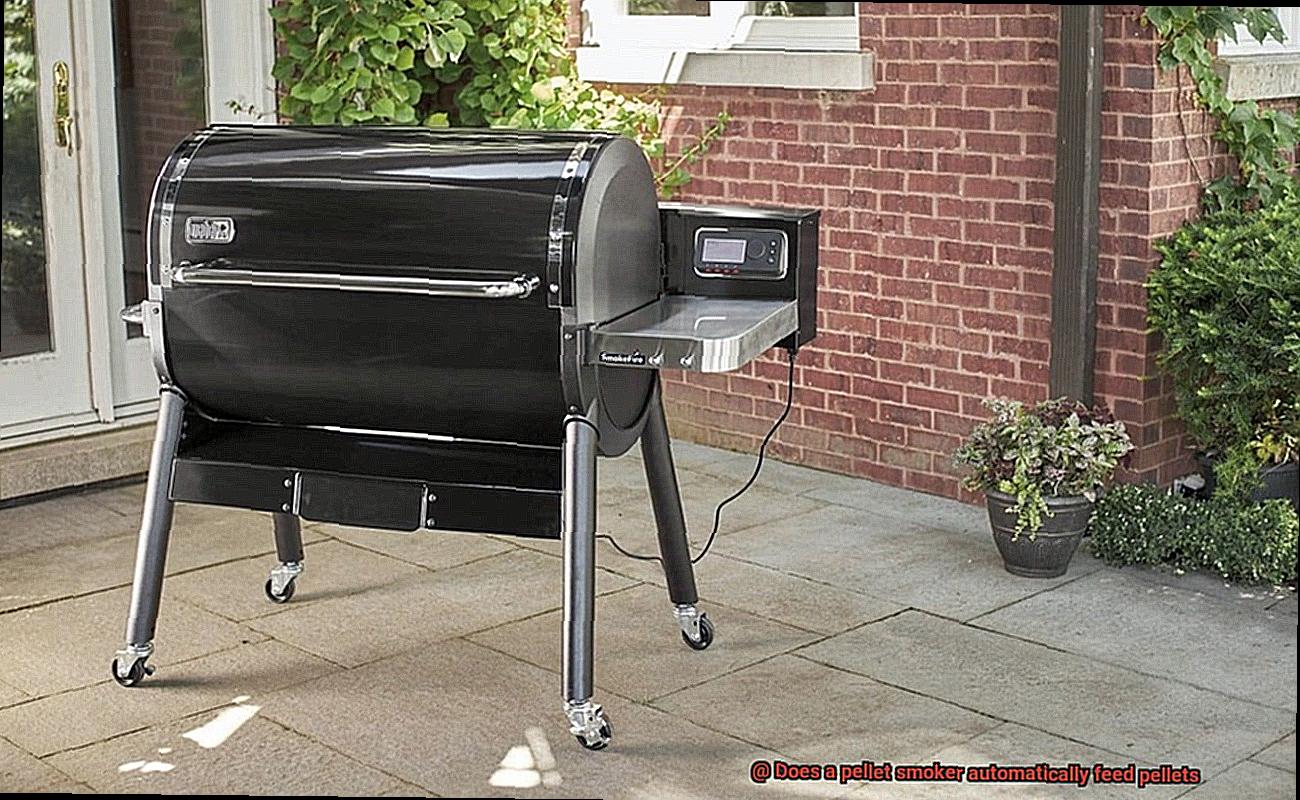
In summary, here are the pros and cons of using an automatic pellet feeder:
Pros
- Precise temperature control
- Time-saving and convenient
- Evenly cooked food
Cons
- Requires electricity to operate
- May lack traditional smoky flavor
- Not ideal for remote locations without power
Alternatives to Automatically Fed Pellet Smokers
Pellet smokers have become increasingly popular due to their ease of use and convenience. However, if you prefer a more hands-on approach or want to explore different flavors of smoked meat, there are alternative options available.
One such option is a charcoal smoker. Though it requires more effort to use than pellet smokers, charcoal smokers offer a unique flavor profile that some people prefer over the taste of meat cooked on a pellet smoker. Charcoal smokers also allow for more control over temperature and smoke levels, which can be important for achieving certain types of meat.
For an even more hands-on approach, consider a wood-fired smoker. These use wood chips or chunks to create smoke and flavor, but they require more effort to maintain a consistent temperature. However, the smoky taste they provide cannot be replicated with pellets.
If you prefer a more hands-off approach, electric smokers may be the way to go. They use electricity to heat up metal rods or coils that produce smoke from wood chips. While they are easy to use and control the temperature with a thermostat, they do not offer the same level of smoky flavor as other types of smokers.
Gas smokers are another alternative to pellet smokers. These use propane or natural gas to heat up the cooking chamber and create smoke from wood chips or pellets. They are easy to use and control the temperature with a thermostat, but they do not offer the same level of smoky flavor as other options.
o0kalLgf2AQ” >
Conclusion
To sum up, pellet smokers are a fantastic option for barbecue enthusiasts who want to enjoy a hassle-free cooking experience. Thanks to their automatic feeding system, you can cook for up to 20 hours straight without worrying about constantly adding more pellets. The motorized auger moves the wood pellets from the hopper into the fire pot, while the digital controller maintains a consistent temperature and adjusts the auger’s speed as needed.
Pellet smokers come in different models with various features such as programmable temperature settings and multiple hopper sizes. Therefore, it’s essential to research and choose one that suits your specific needs. The benefits of an automatic feeding system include consistent temperature control, extended cooking time, customizable smokiness, and energy efficiency.
However, there are some downsides to using an automatic pellet feeder. For instance, it requires electricity to operate and may lack traditional smoky flavor. If you prefer a more hands-on approach or want to experiment with different flavors of smoked meat, alternative options like charcoal smokers, wood-fired smokers, electric smokers, or gas smokers may be worth considering.
Ultimately, the decision comes down to personal preference and convenience. Regardless of which type of smoker you choose, make sure you understand how it works and follow proper maintenance procedures for optimal performance.

